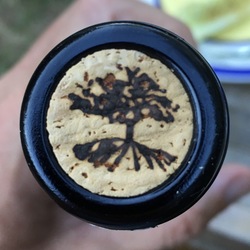Empire Estate
Tablelands
Martinborough Sauvignon Blanc
The Empire latest November 2018 - June 2020 - very good. — 5 years ago
Krug
Brut Rosé Champagne Blend
There are certain occasions that call for Krug Rosé. So, HBTM! The bottle was corked in the summer of 2014. It’s a blend of 45 reserve wines with the oldest being from 2007 and the youngest 2002. This is why I think Champagne Makers are some of the most talented people making wine. They are constantly blending up to 100 plus wines to bring that bottle to bottle and year to year branded flavor of consistency. On the nose; red & pink spring flowers, cherries, strawberries, watermelon, black cherry, black raspberries, notes of blood orange citrus, baked bread, soft volcanic mineral and elegant chalkiness. The palate is always ridiculously delicate. Micro bubbles, silky rich texture with beautiful soft acidity. The palate fruits are similar to the nose; rich & ripe cherries, strawberries watermelon, black cherry, black raspberries, notes of blood orange citrus with hints of marmalade. Red & pink spring flowers, baguette crust, soft powdery minerals that give the palate a slight sting and super powdery chalkiness done just right. The finish is beautifully rich, textured, revealing itself in layers and lasts minutes. Photos of; Founder Joseph Krug, House of Krug, Winemaker Eric Lebel, Krug’s Clos du Mesnil, a small plot of 1.85 hectares of Chardonnay...one of the world’s greatest vineyards and their salon tasting room. Producer history & notes...Krug was founded by Joseph Krug in 1853. They are based in Reims, the main city in France’s Champagne region. It is one of the famous Champagne houses that formed part of the Grande Marques. Today the house is majority owned by the multinational conglomerate LVMH, which owns Moët Hennessy, Louis Vuitton S.A. and who’s wine producer portfolio includes other well known wine brands such as; Moët & Chandon, Veuve Clicquot, Château d'Yquem, Ruinart & Cheval Blanc, Dom Perignon and many others. Despite LVMH's majority ownership, the family is still actively involved in all the key decisions of the house but does not manage the day-to-day operations. Joseph Krug was born Johann-Joseph Krug, a butcher’s son, in Mainz, on the Rhine in 1800 when the city was part of the Napoleonic Empire. Having dispensed with the name Johann, he left Mainz in 1824 and in 1834 moved on to Paris. Germans were in demand in France as accountants and bookkeepers. So, Joseph joined Champagne Jacquesson in Châlons-sur-Marne. He spent eight years with Jacquesson. His work took him beyond accountancy. He went around Europe testing the market and assessing criticism from wine sellers and customers. He learned about composition and taste so that by 1840 he already seemed to have been blending Champagne for at least one other house. In 1841, he married Emma-Anne Jaunay. The daughter of a French hotelier based in London’s Leicester Square. The following year their son Paul Krug was born. In 1842 he moved to Reims and following a year later, Krug et Cie was founded with his partner, Hyppolite de Vivès. Joseph was fluent in French, English and German and even spoke some Russian, putting the company in position to exploit key overseas markets. Joseph died in 1866 and was succeeded by his son Paul Krug, who had been trained by his father to takeover. Joseph under the supervision of Paul, Krug was established as a Grande Marque. By the 1880s the prestige of Krug was acknowledged in the United Kingdom and became the primary overseas market for Champagne. In 1866, the House moved into Rue Coquebert, in Reims as it remains. After Paul’s death in 1910, he was succeeded by his son, Joseph Krug II. However, during World War I Joseph II was taken prisoner and his wife Jeanne played a key role in the House at a time when the Western Front divided the region between the Allies and the Germans. After the war, Joseph II’s slow recovery led to his nephew Jean Seydoux becoming joint manager in 1924. In that decade, the Krug 1926 and 1928 vintages were created, which have been considered by critics to be amongst the greatest Champagnes. Lawyer and wine writer Maurice Healey declared “Krug” the king of all Champagnes. Further, “that the 1928 Krug was the best wine made in the present century.” By the mid-1930s, Paul Krug II, the son of Joseph II, was active in the business and would become head of the House from 1959 to 1977. His father died in 1967, by which time he was, according to Patrick Forbes, “one of the most popular and respected figures in the Champagne district.” In 1962 Henri Krug, the son of Paul II, joined the management, as did his brother Remi three years later. Their arrival was followed by a series of innovations, including extensions in the range of Champagnes. In 1979, for the first time, a graduate winemaker joined the House. In January 1999, the House became part of LVMH and by 2007, the brothers, while remaining on the tasting committee, had stepped down from day-to-day responsibilities. In 2009 Olivier Krug, the son of Henri, became House Director. At harvest, Krug grapes are pressed close to their plots with the first juice kept for 24 hours in a vat prepared for the fermentation stage. The pressing from each plot is vinified separately. A pressing contains 4,000 kilos of grapes and yields 20.5 hectolitres of first juice (cuvée), which is poured into twelve oak casks chosen at random. Once fermentation is complete, the eleventh and twelfth casks are used to top up the other ten casks in order to protect the new wines from oxidation. For fifteen days, each cask is topped up with wine from the same plot. Krug uses small 205 liter oak casks tailor-made from trees that are more than two centuries old in the forests of Hautes Futaies in Central France. The average age of Krug oak casks is 20 years. They are retired after approximately 40 years of use. The wines remain in the casks for several weeks. During this period, clarification occurs naturally from the cool temperature of the cellar given the coming winter, as does a micro-oxygenation process from the use of natural containers, making the wine more resistant to oxygen over time. Finally, between December and January, the wine is drawn off into small stainless-steel vats. From here, depending on the decisions of Krug’s tasting committee, the wines will either contribute to that year’s assemblage or be stored in steel vats in the House’s library of 150 reserve wines to be used in the blend of a future Krug Grande Cuvée and or Krug Rosé. — 6 years ago

Domaine Lelievre
Auxerrois Côtes de Toul Pinot Gris
Second Empire — 9 years ago
The Fifth Empire
Abstracto Tupungato Cabernet Sauvignon
Full bodied with a good amount of spice and dark fruit flavor..,paired well with grilled NY strip steaks with sweet potato. — 5 years ago
Empire Estate
Reserve Finger Lakes Dry Riesling 2016
As someone who drinks a shit ton of riesling, I confidently declare this the best domestic riesling! Though labeled a dry/trocken wine this drinks like an off dry. Reminds me of Rheingau in style. Go get you some reserve! — 6 years ago
Tarlant
Zero Brut Nature Champagne Blend
Awesome farmer fizz on our way to our Willamette Valley honeymoon! Aboard the Amtrak Empire Builder passing through Montana right now. NV with 2007 base wines; 2/2014 disgorgement. Spends 5 years on lees and has the rich autolytic character to show for it but still has focus and plenty of verve as well. Pours a medium gold hue. Rich, concentrated nose of ripe as well as baked yellow apples, leesy autolytic fresh brioche notes, crushed chalk, Parmigiano rind, subtle almond and a tiny bit of baking spice character. Cohesive and harmonious nose. On the palate, it's a bit more focused and mineral driven, still has the same ripe yellow apple, autolytic/leesy, and almond notes but with the crushed chalk minerality taking a more central role. Acid is medium (+) to high, medium (-) body, bone dry,
alcohol is moderate and in balance. Some pretty stellar stuff made even better by the context in which it's being consumed. ❤️ — 7 years ago



Antiche Terre Venete
Amarone della Valpolicella Corvina Blend
$20.85@Empire Wine — 8 years ago
Fumanelli
Valpolicella Classico Superiore Corvina Blend 2013
$20.95 @ Empire Wine A really nice wine. Everyone at the table enjoyed it. Received compliments from my Italian uncle. — 8 years ago
Onabay Vineyards
Night Heron Cabernet Franc 2010
Received this two years ago from the no-longer-extant Empire Wine Cellars club. This is a delicious, balanced, well made, structured wine. At $28 it's a complete steal. Damp earth and dark fruit along with velvety textures and lip-smacking fruit concentration. If you like cab franc, you need to take a peek at Onabay. — 8 years ago
The Fifth Empire
Abstracto Malbec
Would absolutely buy again. Great value. Total Wine. — 5 years ago
Domaine Lafage
Tessellae Côtes Catalanes Vieilles Vignes Carignan
Molto buono. Pensiando il preso(forse sotto 15dollari) sarebbe il buono mercato. Ho bisono di predere un paio di botteglie. Penso che ho avuto al’enoteca di Empire che e il mio favarito. — 5 years ago
Empire
Winemaker's Reserve Napa Valley Cabernet Sauvignon 2015
Zesty, fresh, and ripe. Dark fruited and polished tannin. A solid Cab good acidity. — 6 years ago
Deux Montille
Les Preuses Grand Cru Chablis Chardonnay 2013
Delicious white, goes down smooth and has a nice crisp in the end - with nick and Jeanette at empire diner friends and family — 7 years ago
Empire Wine
Cuvée Darius Fitou Mourvèdre Blend 2013
Nice plum and cherry compote nose. Bit of bitterness. Dry and chocolate-y. Some funky-town. Southern French style and done well. — 7 years ago
Candoni
Moscato
Before the rise of Roman Empire, Etruscan, ancient is tasted in this fine light bodied wine. A delight taste of sweetness hits the tip of the tongue allowing your palate to taste oranges and an acidity finish. — 8 years ago
Empire des Bateaux
Bordeaux Cabernet Sauvignon 2013
I like this one - smooth and comfortable!!! A good cheap red! — 8 years ago
Two Shepherds
Saralee's Vineyard Grenache 2013
American Grenache at its finest! Desert rose, cherries, and strawberry aromas give way to pomegranate, empire cherry, raspberry, and mixed citrus peel on the palate. Wonderful acidity helps the tastes linger. I think having William sign so many of my bottles adds something special, too! — 8 years ago
J&J Eger Wine Co
Eged-Hegy Dülö Kékfrankos 2009
Sundried tomatoes with some dried oregano and herbs. Little bit of olives. Acid is nice. Sole cranberry sandal wood and Rose hips contrast and no so subtle mineralality. The kekfrankos is the Same as the blaufrankisch. 1530s the bull's blood wine. The story goes that the people were surrounded, drank all the wine and charged an attack against the Ottoman Empire. Killed the head of the snake and they scattered. Not sure if the legend is true but it's The only town in the Ottoman Empire area that has been left pristine. 😏 regardless it's a darn good wine — 9 years ago








Tetsu Nakazawa
Ho trovato questo all’enoteca mia favarita (Empire State Wine). Ringrazio che sono aperti durante questo duro period. E molto buono, come la botteglia da super tascan (Mongrana). Ma buono mercato. L’abbiamo bevuto di nuovo una settimana fa dopo aperto, era buono abbastanza ancora. — 4 years ago